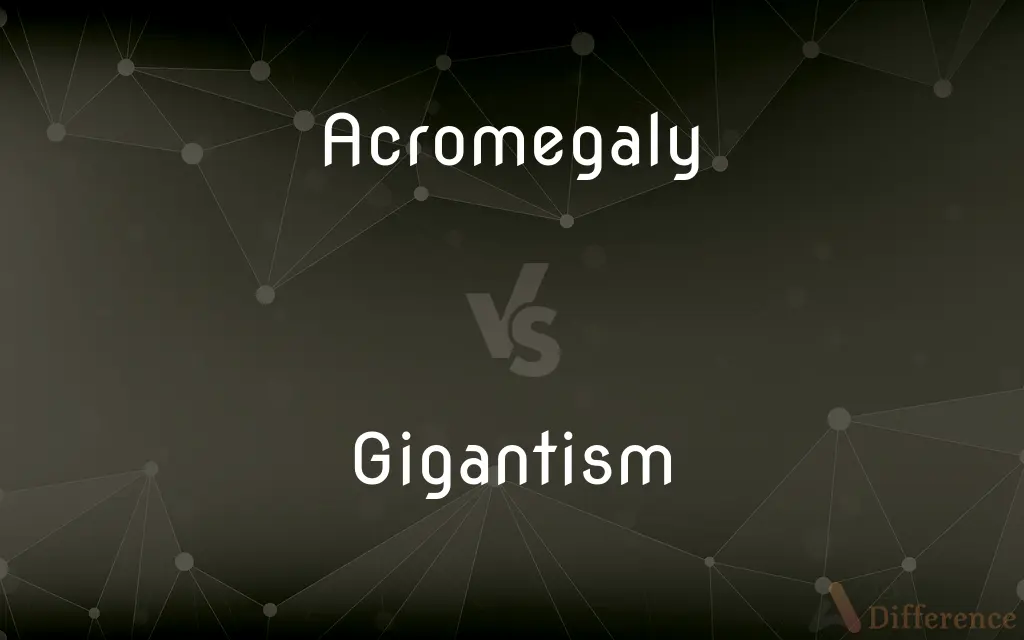Acromegaly vs. Gigantism — What's the Difference?
By Tayyaba Rehman — Updated on October 30, 2023
Acromegaly is a hormonal disorder causing enlarged extremities and organs in adults, while gigantism results in abnormal height due to excessive growth hormone in children.

Difference Between Acromegaly and Gigantism
Table of Contents
ADVERTISEMENT
Key Differences
Acromegaly occurs in adults, typically middle-aged. Gigantism occurs in children, affecting their growth.
Acromegaly leads to enlarged hands, feet, and facial features. Gigantism results in abnormal height and rapid growth.
Both are caused by excess growth hormone, often due to a pituitary tumor. However, the timing of hormone excess differs.
Acromegaly can cause joint pain and organ enlargement. Gigantism can lead to physical discomfort due to rapid growth.
Treatment may involve surgery, medication, or radiation. The approach depends on the condition's progression and severity.
ADVERTISEMENT
Comparison Chart
Onset Age
In adults
In children
Symptoms
Enlarged extremities, organs
Abnormal height, rapid growth
Cause
Excess growth hormone in adulthood
Excess growth hormone in childhood
Health Effects
Joint pain, organ enlargement
Physical discomfort due to size
Treatment
Surgery, medication, radiation
Surgery, medication, radiation
Compare with Definitions
Acromegaly
Acromegaly is caused by excess growth hormone.
The tumor caused growth hormone overproduction, leading to acromegaly.
Gigantism
Gigantism is a growth disorder leading to excessive height.
His towering stature was due to gigantism.
Acromegaly
Acromegaly typically develops in adults.
Acromegaly usually doesn't manifest until adulthood.
Gigantism
Gigantism occurs during childhood.
Gigantism typically manifests before adolescence.
Acromegaly
Often caused by a pituitary tumor.
The diagnosis was acromegaly, triggered by a pituitary tumor.
Gigantism
Gigantism involves rapid and abnormal growth.
His rapid growth spurt was a sign of gigantism.
Acromegaly
Acromegaly is a hormonal disorder causing enlargement of body parts.
His enlarged hands indicated acromegaly.
Gigantism
Often due to a pituitary tumor.
The child's gigantism was caused by a tumor in the pituitary gland.
Acromegaly
Acromegaly includes symptoms like enlarged facial features.
His pronounced jawline was a symptom of acromegaly.
Gigantism
Gigantism (Greek: γίγας, gígas, "giant", plural γίγαντες, gígantes), also known as giantism, is a condition characterized by excessive growth and height significantly above average. In humans, this condition is caused by over-production of growth hormone in childhood, resulting in people 2.1 to 2.7 m (7 to 9 ft) in height.It is a rare disorder resulting from increased levels of growth hormone before the fusion of the growth plate which usually occurs at some point soon after puberty.
Acromegaly
Acromegaly is a disorder that results from excess growth hormone (GH) after the growth plates have closed. The initial symptom is typically enlargement of the hands and feet.
Gigantism
The quality or state of being gigantic; abnormally large size.
Acromegaly
A chronic disorder caused by overproduction of human growth hormone usually by the pituitary gland, characterized by enlargement of the bones of the extremities and the skull and often by the development of complications such as diabetes, hypertension, and osteoarthritis.
Gigantism
Excessive growth of the body or any of its parts, especially as a result of oversecretion of the growth hormone by the pituitary gland. Also called giantism.
Acromegaly
(disease) A chronic disease marked by enlargement of the bones of the extremities, face, and jaw that is caused by over-activity of the pituitary gland.
Gigantism
The quality or state of being gigantic; being of abnormally large size.
Acromegaly
Chronic enlargement of the extremities and face.
Gigantism
A condition where there is over-production of growth hormone by the pituitary gland in a child before the bone growth plates close, resulting in excessive long bone growth, accompanied by muscular weakness and sexual impotence.
Acromegaly
Enlargement of bones of hands and feet and face; often accompanied by headache and muscle pain and emotional disturbances; caused by overproduction of growth hormone by the anterior pituitary gland (due to a tumor)
Gigantism
Excessive size; usually caused by excessive secretion of growth hormone from the pituitary gland
Gigantism
Excessive largeness of stature
Gigantism
Gigantism is caused by overproduction of growth hormone.
The excessive growth hormone resulted in gigantism.
Common Curiosities
Can gigantism be cured?
Treatment can manage symptoms and control growth, but a complete "cure" depends on the condition's severity.
What are common symptoms of acromegaly?
Enlarged hands, feet, facial features, and joint pain are common.
What causes acromegaly?
Acromegaly is often caused by a benign tumor on the pituitary gland.
Is acromegaly hereditary?
It's not typically hereditary and usually occurs sporadically.
How is gigantism diagnosed?
Diagnosis involves hormonal tests, MRI scans, and physical examinations.
Can acromegaly develop in children?
No, acromegaly occurs in adults. In children, it's called gigantism.
How does gigantism affect growth?
It causes rapid and excessive growth, leading to abnormal height.
What is the main difference between acromegaly and gigantism?
Acromegaly occurs in adults; gigantism occurs in children.
Can acromegaly be prevented?
Since it's often due to a pituitary tumor, it's not generally preventable.
Can gigantism lead to other health issues?
Yes, it can cause joint pain, cardiovascular problems, and more.
Does gigantism affect life expectancy?
If untreated, it can reduce life expectancy due to related health issues.
What are treatment options for acromegaly?
Surgery, medication, and radiation therapy are common treatments.
What are complications of acromegaly?
Complications can include diabetes, hypertension, and arthritis.
How fast does gigantism progress?
It varies but can lead to rapid growth over a short period.
Share Your Discovery

Previous Comparison
Awake vs. Alert
Next Comparison
Action vs. ObligationAuthor Spotlight
Written by
Tayyaba RehmanTayyaba Rehman is a distinguished writer, currently serving as a primary contributor to askdifference.com. As a researcher in semantics and etymology, Tayyaba's passion for the complexity of languages and their distinctions has found a perfect home on the platform. Tayyaba delves into the intricacies of language, distinguishing between commonly confused words and phrases, thereby providing clarity for readers worldwide.














































